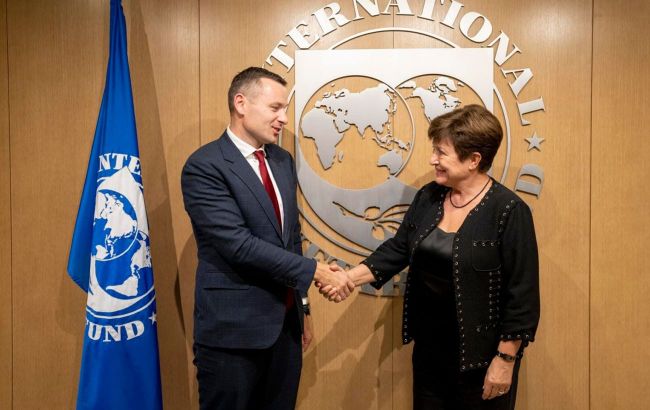Prolonged war and financial shortfalls: How the IMF sees Ukraine's future
 In 2025, Ukraine may need more funds (photo: Facebook of Serhii Marchenko)
In 2025, Ukraine may need more funds (photo: Facebook of Serhii Marchenko)
The financial and economic situation in Ukraine next year may be more challenging than the current one, according to the International Monetary Fund. If there is a lack of international assistance, funding will need to be sought within the country. RBC-Ukraine investigates what might serve as sources of these funds.
Contents
- New downside scenario with war ending in 2026
- Increased funding for 2025
- Large amounts of funds promised, though no guarantees yet
- VAT rate outlook
The scenario for Ukraine, which the IMF previously considered pessimistic over the summer, is now viewed as the baseline. This includes an end to the war in 2025, even though in June, the Fund considered such a possibility by the end of the current year.
This information is part of an updated memorandum of cooperation with the International Monetary Fund.
New downside scenario with war ending in 2026
According to a new negative scenario, the war is projected to end by mid-2026. In this case, economic growth for 2024 is forecasted at only 1%, with a 2.5% decline in real GDP in 2025. Inflation is expected to reach 12% this year, then drop to 10% in 2025 and 8% in 2026. Meanwhile, the 2025 budget was initially based on an anticipated GDP growth of 2.7% and inflation of 9.5%.
Increased defense needs will lead to a rise in budget deficits in 2025 and 2026. An additional $35.7 billion will be required to cover this deficit during this period.
"The updated cumulative financing gap in the downside scenario is estimated at US$187.1 billion, US$35.7 billion higher than the baseline forecast for 2023Q2–27Q1 (US$151.4 billion), requiring additional steps to ensure debt sustainability," the memorandum states.
This funding need can be met by increasing external infusions and domestic revenues.
Increased funding for 2025
In 2025, Ukraine expects to receive $38.6 billion from international partners, including $11.9 billion from the European Union, $3.1 billion from the European Bank for Reconstruction and Development (EBRD), and $19.1 billion from other allies.
The IMF has already increased its 2025 funding by nearly $810 million and optimized the disbursement schedule. Instead of two tranches, Ukraine is expected to receive four next year.
Sources familiar with IMF negotiations indicated that this adjustment was made to smooth the disbursement schedule, as initially, more funds were planned for 2026 than for 2025. Increasing the number of tranches will provide more regular access to international assistance and reduce the risk of prolonged gaps in funding, as seen this year.
"When the EFF program was adopted in 2023, everyone assumed the war would end in 2025, and accordingly, a more intensive allocation of funds was planned for 2023–2024. There were only two reviews planned for 2025, but now there will be four," said Danylo Hetmantsev, Head of Verkhovna Rada of Ukraine Committee on Finance.
He also noted that increasing the number of tranches will allow the Fund to impose more requirements on Ukraine and monitor their fulfillment more intensively. Moreover, Hetmantsev connects the schedule adjustment with funding from other partners.
"In its updated forecast, the IMF assumes the war will continue throughout the next year. Therefore, it must also increase funding, albeit not as proportionally as the EU and the US But this will remain within the program (the four-year program totals $15.6 billion)," he said. To significantly increase the Fund’s support, the program would have to be entirely revamped.
Large amounts of funds promised, though no guarantees yet
Regarding funding from other external sources, the current discussions on this matter are encouraging. The EU is finalizing work on allocating up to €35 billion in macro-financial assistance to Ukraine as part of the G7 initiative, secured by revenues from frozen Russian assets. The European Parliament and the EU Council have already approved this decision. In the US, there are talks of providing Ukraine with up to $20 billion under the G7 loan framework. The UK has announced a loan of $3 billion. Decisions from other G7 participants — Canada and Japan — are expected.
Considering that the US will provide up to $20 billion, plus contributions from the UK, Japan, and Canada, the EU's loan amount may be less than €35 billion, as the total loan amount is limited by potential revenues from frozen Russian assets, which is $50 billion. The conditions for receiving these loan funds have not yet been determined — the agreements will be signed with each creditor separately.
Additionally, the Ukraine Facility program has been launched, with total support amounting to €50 billion by 2027. In April, the US passed a law to support Ukraine with $61 billion.
For now, there are many promises, but predicting which of them will be fulfilled and to what extent is difficult. "The risks of receiving external financing in full are present, but they are still lower than last year (when the delay in financing was related to the lack of an approved US budget - Ed.). The situation with the $50 billion loan based on profits from frozen Russian bank assets is moving toward a logical conclusion," noted Hetmantsev.
He also does not rule out that the increase in funding from the IMF in 2025 may not be so much for the safety of Ukraine but rather to provide additional motivation for other partners to increase support for the war-torn country.
VAT rate outlook
Ukraine's partners, in turn, are behaving cautiously, carefully monitoring each other's actions. Neither the EU nor the USA intends to take on inflated commitments— everyone wants to participate in aiding Ukraine proportionally. It is likely for this reason that the decision to provide credit to Ukraine was made almost simultaneously by Brussels and Washington.
However, if financial support is provided to Ukraine, the creditor partners want the country to seek internal reserves for budget financing. This is reflected in the latest version of the IMF memorandum. "To ensure budget compliance, we will respond to income shortfalls or new expenditure requirements by increasing taxes. We consider raising the basic VAT rate as the most effective potential source of additional revenue at this stage," the Ukrainian side states in the document.
RBC-Ukraine has already reported that raising VAT by 2 percentage points — to 22% — was actively discussed during the review of the IMF program. However, this has been avoided so far. But Ukraine has promised the Fund that the VAT rate will be increased if the situation next year does not develop according to the baseline scenario.
Vitaliy Vavryshchuk, Head of the Macroeconomic Research Department at ICU Group, does not rule out that the requirement to raise VAT may arise sooner.
"For now, raising VAT is not the baseline scenario. But if we look realistically, the IMF may insist on raising VAT in any case, so that it does not have to be done in emergency mode and retroactively, as happened with the military levy," he commented to RBC-Ukraine.
Additionally, in the event of a negative scenario, it may be necessary to reintroduce some currency control measures that were previously applied during the war, according to the memorandum.
Sources familiar with the negotiation process say that the introduction of a fixed exchange rate for the hryvnia is not being discussed. In Vavryshchuk's opinion, it is more likely that restrictions on the purchase of currency and capital outflow abroad will be considered for both legal entities and individuals.
"I think that such measures may be introduced to reduce pressure on the currency market if there is less external assistance than is projected in the baseline scenario. If reserves are 'melting away,' then it will not be possible to release currency from the country as it is now," he said in a comment to RBC-Ukraine.
So far, this is the forecast for next year. By the end of the current year, Ukraine expects over two billion dollars more from its partners, including another IMF tranche of 1.1 billion dollars in December. In total, of the 38 billion dollars needed for 2024, according to the Ministry of Finance as of mid-October, 35.7 billion dollars have already been received.

